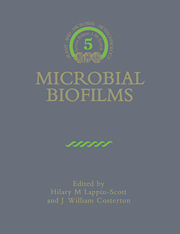Book contents
- Frontmatter
- Contents
- List of Contributors
- Series Preface
- Introduction to Microbial Biofilms
- Part I Structure, Physiology and Ecology of Biofilms
- Part II Biofilms and Inert Surfaces
- Part III Biofilms on the Surfaces of Living Cells
- 12 The Rhizosphere as a Biofilm
- 13 Biofilms of the Ruminant Digestive Tract
- 14 The Immune Response to Bacterial Biofilms
- 15 Bacterial Biofilms in the Biliary System
- 16 Biofilm Associated Urinary Tract Infections
- 17 The Role of the Urogenital Flora in Probiotics
- 18 Dental Plaque
- Index
15 - Bacterial Biofilms in the Biliary System
Published online by Cambridge University Press: 24 November 2009
- Frontmatter
- Contents
- List of Contributors
- Series Preface
- Introduction to Microbial Biofilms
- Part I Structure, Physiology and Ecology of Biofilms
- Part II Biofilms and Inert Surfaces
- Part III Biofilms on the Surfaces of Living Cells
- 12 The Rhizosphere as a Biofilm
- 13 Biofilms of the Ruminant Digestive Tract
- 14 The Immune Response to Bacterial Biofilms
- 15 Bacterial Biofilms in the Biliary System
- 16 Biofilm Associated Urinary Tract Infections
- 17 The Role of the Urogenital Flora in Probiotics
- 18 Dental Plaque
- Index
Summary
Introduction
Cholangitis consists of bacterial infection of bile in the biliary system. The syndrome of acute cholangitis has been well recognized since Charcot (1877) described the classical triad of pain, fever and jaundice in these patients. It is an important cause of abdominal emergency cases and septicaemia with a high rate of morbidity and mortality (Li et al. 1985; French et al. 1990). Biliary obstruction, due to gallstones obstructing the bile ducts, or to benign or malignant stricture of the biliary tract, is an essential element in the development of cholangitis. In the past decade, endoscopic drainage by biliary stenting has become a standard procedure in palliation for inoperable biliary malignancies and some cases of large biliary stones causing obstructive jaundice. Unfortunately, there is an increased incidence of cholangitis related to the blockage of the biliary stents with the use of this technique (Huibregtse et al. 1986; Cotton 1990). Some studies have revealed that the pathogenesis of pigment gallstones (Stewart et al. 1987; Leung et al. 1988), and the blockage of the biliary stents (Leung et al. 1988; Speer et al. 1988) are closely related to the formation of bacterial biofilms in which the glycocalyx enclosed microcolonies coalesce to form an adherent structure (Jacques et al. 1987). This chapter reviews the present knowledge of the microbial ecology of the biliary system, formation of bacterial biofilm from bacterial infection within this system, the pathogenesis of brown biliary pigment stone and blockage of the biliary stent.
- Type
- Chapter
- Information
- Microbial Biofilms , pp. 251 - 260Publisher: Cambridge University PressPrint publication year: 1995
- 2
- Cited by

